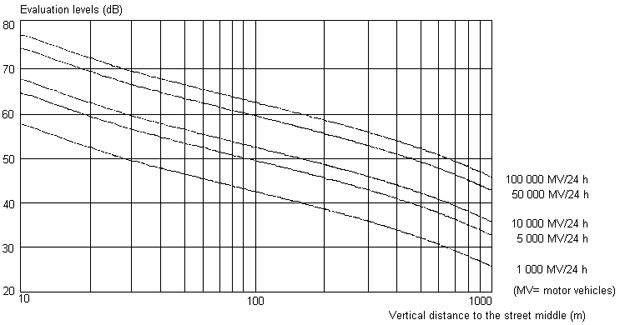The evaluation level was calculated for the selected areas and shown on the map in color, with a 5 dB(A)-graduation. The only source used for the noise pollution was the data on the motor vehicle and streetcar traffic of the main traffic arteries. Other noise sources, such as the traffic of the side-street network, the rail traffic of the city rail system, the subway and the Federal Railway, air traffic, and industrial and commercial noise, were not considered.
The evaluation level shown on the map was ascertained for the motor vehicle traffic on the basis of the “Guidelines for Noise Prevention on Streets” (RLS-90) and for the streetcar traffic on the basis of the “Guidelines for the Calculation of the Noise Pollution of Rail Traffic” (Schall 03).
For the calculation of the evaluation level, the mean levels were added for motor vehicles and streetcars. Thus, the streetcar noise was fully integrated into the calculation. The allowance of 5 dB(A) for rail traffic (“rail bonus”), which is contained in some guidelines and norms, is not utilized on streetcar noises in the inner-city area. Start-up and braking processes of vehicles at traffic-light-regulated intersections were arrived at by a distance-dependent addition of up to 3 dB(A) into the calculation of the evaluation level.
The calculations were undertaken for the mean ear height of a standing person (about 1.6 m), taking into consideration such large-scale screens as roadside developments, noise-prevention walls or extended mounds. For a lying person small-scale screening and increased floor insulation can result in up to 10 dB(A) less noise pollution.
The basis of the calculation is the average daily traffic volume mean for all days of a year. In addition to that, a day-time mean is calculated for the time from 6 AM – 10 PM, in order to determine the evaluation of the level per day. The evaluation level thus provides a year-round median value for the time between 6 AM and 10 PM. Particularly on Sundays and holidays, lower levels of noise pollution can occur, because of generally decreased flows of traffic, as is shown on the map. Streets which serve predominantly weekend traffic can, however, show higher noise pollution levels on Sundays and on holidays.
Because of the non-consideration of the side-street network (for this, no data exist from traffic counts), significant deviations of the calculated evaluation level from the actual noise pollution level may occur, particularly in the areas shown as having slight noise pollution (less than 45dB(A)).

